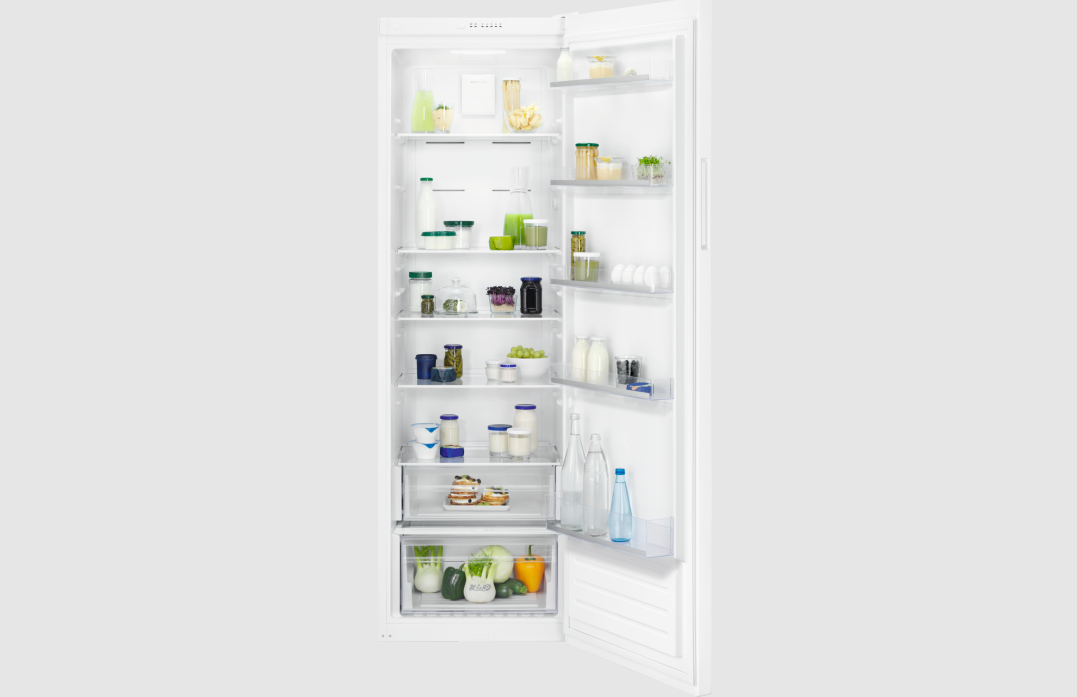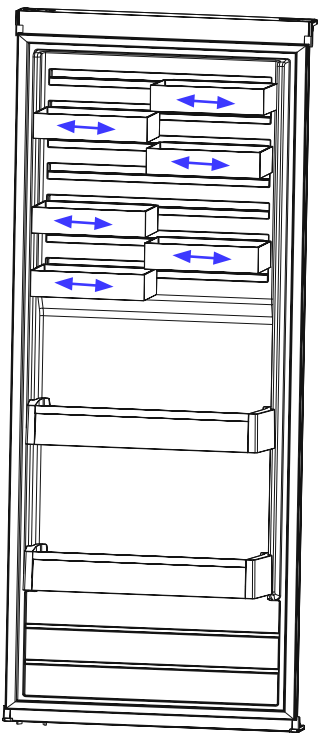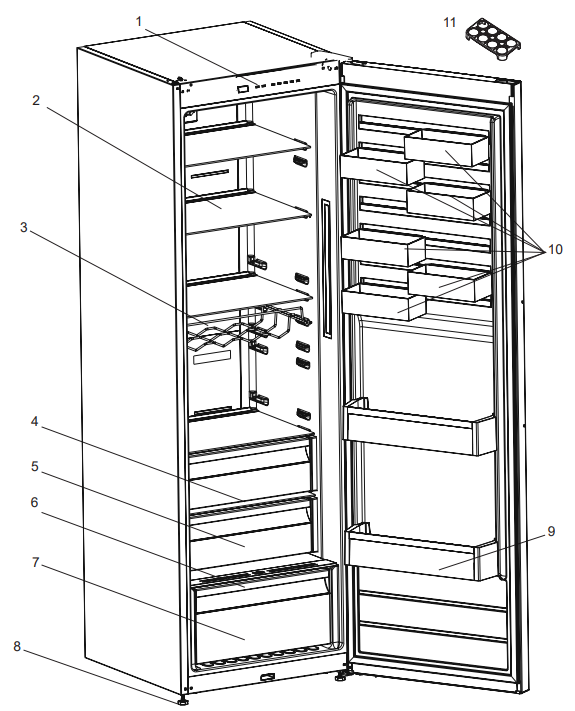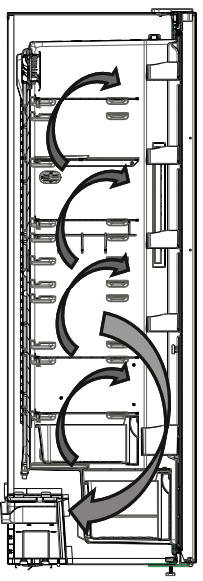Zanussi Cabinet Fridge & Freezer ZRME38FW2 User Manual

Content
Introduction
The Zanussi Cabinet Fridge & Freezer ZRME38FW2 is designed for efficiency and convenience, offering ample storage space while ensuring optimal food preservation. This model features advanced cooling technology, including an Active Defrost System and energy-efficient components, making it suitable for both home and professional kitchens. With a sleek design and easy-to-clean interiors, it combines functionality with style. The cost of the Zanussi ZRME38FW2 is $1,200.
Accessories
Extra Chill Compartment (In some models)
Ideal to preserve the taste and texture of fresh cuts and cheese. The pull-out drawer assures an environment with a lower temperature compared to the rest of the fridge, thanks to the active circulation of cold air.

CustomFlex (In some models)
CustomFlex offers you the freedom to customize the space in your refrigerator. Inside of the door, there are a storage container and mobile containers, so you can tailor the space to your needs. The containers are even removable, so you can remove them from the refrigerator for easy access.

The Fresh Dial (In some models)
If the crisper is full, the fresh dial located in front of the crisper should be opened. This allows the air in the crisper and the humidity rate to be controlled, to increase the life of food within.
The dial, located behind the shelf, must be opened if any condensation is seen on the glass shelf.

Specifications
- Capacity: 272 liters (fridge) + 124 liters (freezer)
- Energy Efficiency Class: A+
- Noise Level: 39 dB(A)
- Temperature Range: -18°C to +5°C
- Auto Defrost Function
- Adjustable Shelves and Drawers
- Multiair Flow Technology for even cooling
Dimensions

the height, width, and depth of the appliance without the handle
Overall dimensions 1 H1 mm 1860 W1 mm 595 D1 mm 650 the height, width, and depth of the appliance including the handle, plus the space necessary for free circulation of the cooling air
Space required in use 2 H2 mm 2010 W2 mm 600 D2 mm 739 the height, width, and depth of the appliance including the handle, plus the space necessary for free circulation of the cooling air, plus the space necessary to allow door opening to the minimum angle permitting removal of all internal equipment
Overall space required in use
3
W3 mm 967
D3 mm 1179
DESCRIPTION OF THE APPLIANCE

This presentation is only for information about the parts of the appliance. Parts may vary according to the appliance model.
- Control panel
- Refrigerator shelves
- Wine rack (Bottle shelf)
- Upper crisper *
- Chiller shelf *
- Crisper cover
- Crisper
- Levelling feet
- Bottle shelf
- CustomFlex*
- Egg holder
TECHNICAL DATA
The technical information is situated in the rating plate on the internal side of the appliance and on the energy label. The QR code on the energy label supplied with the appliance provides a web link to the information related to the performance of the appliance in the EU EPREL database.
Keep the energy label for reference together with the user manual and all other documents provided with this appliance.
It is also possible to find the same information in EPREL using the link https://eprel.ec.europa.eu and the model name and product number that you find on the rating plate of the appliance. See the link www.theenergylabel.eu for detailed information about the energy label.
INFORMATION FOR TEST INSTITUTES
Installation and preparation of the appliance for any EcoDesign verification shall be compliant with EN 62552. Ventilation requirements, recess dimensions and minimum rear clearances shall be as stated in this User Manual at PART 1. Please contact the manufacturer for any other further information, including loading plans.
VARIOUS FUNCTION AND POSSIBILITIES
Information on No-Frost technology
No-frost refrigerators differ from other static refrigerators in their operating principle.
In normal refrigerators the humidity entering the refrigerators due to opening the door and the humidity inherent in the food causes freezing in the backside of air duct. To defrost the frost and ice in the backside of air duct, you are periodically required to turn off the refrigerator, place the food that needs to be kept cooled in a separately cooled.
The situation is completely different in no-frost refrigerators. Dry and cold air is blown into the refrigerator compartment homogeneously and evenly from several points via a blower fan. Cold air dispersed homogeneously and evenly between the shelves cools all of your food equally and uniformly, thus preventing humidity and freezing. Therefore your no-frost refrigerators allows you ease of use, in addition to its huge capacity and stylish appearance.

Display and Control Panel

Using the Control Panel
- Fridge temperature set button
- Super cooling symbol (Super cooling LED)
- Alarm symbol (Alarm LED)
- Fridge adjusted temperature indicator
Operating your Fridge
Lighting (If available)
When the product is plugged in for the first time, the interior lights may turn on 1 minute late due to opening tests.
Fridge Temperature Set Button
This button allows setting temperature of the fridge. In order to set values for fridge partition, press this button. Use this button also to activate super cooling mode.
Alarm symbol (Alarm LED)
In case of a problem within the fridge, the alarm led will release red light.
Super Cooling Mode
When would it be used?
- To cooling huge quantities of food.
- To cooling fast food.
- To cooling food quickly.
- To store seasonal food for a long time.
How to use?
- Press temperature set button until super cooling light comes on.
- Super cooling led will light during this mode.
- For optimal appliance performance in maximum cooling capacity, set the appliance to active super cooling mode 6 hours before you put the fresh food into the fridge.
During this mode:
If you press temperature set button, the mode will be cancelled and the setting will be restored from 2.
NOTE: The super cooling mode will be cancel automatically after 6 hours or when cooling sensor temperature falls below 2 °C.
Fridge Temperature Settings
- The initial temperature of the setting display is 5 °C.
- Press fridge setting button once.
- Every time you press the button, the setting temperature will increase. (2 °C, 4 °C, 5 °C, 6 °C, 8 °C, Super cooling)
- If you press fridge setting button until super cooling symbol is displayed on your fridge.
- Settings display and you do not press any button within the following 3 seconds.
- Super cooling will blink.
- If you keep on pressing, it will restart from last value.
Recommended Temperature Values for Cooler
| When to adjust Inner Temperature (oC) | |
| For cooling the fridge at minimum capacity | 8 |
| In normal usage | 4 |
| For cooling the fridge at maximum capacity | 2 |
Temperature Settings Warnings
- It is not recommended that you operate your fridge in environments colder than 10°C in terms of its efficiency.
- Do not start another adjustment before completing one adjustment.
- Temperature adjustments should be made according to the frequency of door openings and the quantity of food kept inside the fridge.
- When you first switch on the appliance, allow it to operate for 24 hours in order to reach normal operating temperature. During this time, do not open the door or place a lot of food inside the appliance.
- If the appliance is switched off or unplugged, wait at least 5 minutes before plugging the appliance in or restarting it in order to prevent damage to the compressor.
- Your fridge is designed to operate within specific ambient temperature ranges, according to the climate class stated on the information label. We do not recommend operating your fridge outside the stated temperatures value limits.
- Your appliance is designed to operate in the ambient temperature (T/SN = 10°C -43°C) intervals stated in the standards, according to the climate class displayed on the information label. We do not recommend operating your appliance out of the stated temperature limits in terms of cooling effectiveness.
| Climate class | Meaning | Ambient Temperature |
| T | Tropical | This refrigerating appliance is intended to be used at ambient temperatures ranging from 16 °C to 43 °C. |
| ST | Subtropical | This refrigerating appliance is intended to be used at ambient temperatures ranging from 16 °C to 38 °C. |
| N | Temperate | This refrigerating appliance is intended to be used at ambient temperatures ranging from 16 °C to 32 °C. |
| SN | Extended temperate | This refrigerating appliance is intended to be used at ambient temperatures ranging from 10 °C to 32 °C. |
The Turbo Fan (if available)
Do not block the air inlet and outlet openings when storing food, otherwise, air circulation provided by the turbofan will be impaired.
.png)
ARRANGING FOOD IN THE APPLIANCE
- The fresh food compartment is the one marked (on the rating plate) with
 .
. - To reduce humidity and avoid the consequent formation of frost, always store liquids in sealed containers in the refrigerator. Frost tends to concentrate in the coldest parts of the evaporating liquid and, in time, your appliance will require more frequent defrosting.
- Never place warm food in the refrigerator. Warm food should be allowed to cool at room temperature and should be arranged to ensure adequate air circulation in the refrigerator compartment.
- Make sure no items are in direct contact with the rear wall of the appliance as frost will develop and packaging will stick to it. Do not open the refrigerator door frequently.
- We recommend that meat and clean fish are loosely wrapped and stored on the glass shelf just above the vegetable bin where the air is cooler, as this provides the best storage conditions.
- Store loose fruit and vegetable items in the crisper containers.
- Store loose fruit and vegetables in the crisper.
- Storing fruit and vegetables separately helps prevent ethylene-sensitive vegetables (green leaves, broccoli, carrot, etc.) from being affected by ethylene-releaser fruits (banana, peach, apricot, fig, etc.).
- Do not put wet vegetables in the refrigerator.
- Storage time for all food products depends on the initial quality of the food and an uninterrupted refrigeration cycle before refrigerator storage.
- To avoid cross-contamination do not store meat products with fruit and vegetables. Water leaking from meat may contaminate other products in the refrigerator. You should package meat products and clean any leakages on the shelves.
- Do not put food in front of the airflow passage.
- Consume packaged foods before the recommended expiry date.
NOTE: The most efficient use of energy is ensured in the configuration with the drawers in the bottom part of the appliance, and shelves evenly distributed, the position of door bins does not affect energy consumption.
NOTE: Potatoes, onions, and garlic should not be stored in the refrigerator.
The table below is a quick guide to show you the most efficient way to store the major food groups in your refrigerator compartment.
| Food | Maximum storage time | How and where to store |
| Vegetables and fruits | 1 week | Vegetable bin |
| Meat and fish | 2 - 3 Days | Wrap in plastic foil, bags, or in a meat container and store on the glass shelf |
| Fresh cheese | 3 - 4 Days | On the designated door shelf |
| Butter and margarine | 1 week | On the designated door shelf |
| Bottled products e.g. milk and yoghurt | Until the expiry date recommended by the producer |
On the designated door shelf |
| Eggs | 1 month | On the designated egg shelf |
| Cooked food | 2 Days | All shelves |
Setup Guide
To set up your ZRME38FW2,
- Start by ensuring the appliance is placed on a level surface.
- Connect the power cord to a nearby outlet and allow the appliance to cool down for a few hours before loading it with food.
- Adjust the shelves and drawers according to your needs and set the desired temperature using the control panel.
- For proper installation within a cabinet, follow the manufacturer's guidelines for dimensions and clearance.
- Ensure all connections are secure and test the appliance before regular use.
CLEANING AND MAINTENANCE
- Disconnect the unit from the power supply before cleaning.
- Do not wash your appliance by pouring water on it.
- Do not use abrasive products, detergents or soaps for cleaning the appliance. After washing, rinse with clean water and dry carefully. When you have finished cleaning, reconnect the plug to the mains supply with dry hands.
- Make sure that no water enters the lamp housing and other electrical components.
- The appliance should be cleaned regularly using a solution of bicarbonate of soda and lukewarm water.
- Clean the accessories separately by hand with soap and water. Do not wash accessories in a dishwasher.
- Clean the condenser with a brush at least twice a year. This will help you to save on energy costs and increase productivity.
DANGER: The power supply must be disconnected during cleaning. Replacing LED Lighting
NOTE: If your appliance has LED lighting contact the help desk as this should be changed by authorized personnel only.
Transportation and Changing of Installation Position
- The original packaging and foam may be kept for re-transportation (optional).
- Fasten your appliance with thick packaging, bands, or strong cords, and follow the instructions for transportation on the packaging.
- Remove all movable parts (shelves, accessories, vegetable bins, and so on) or fix them into the appliance against shocks using bands when re-positioning or transporting.
NOTE: Always carry your appliance in the upright position.
Repositioning the Door
- It is not possible to change the opening direction of your appliance door if door handles are installed on the front surface of the appliance door.
- It is possible to change the opening direction of the door on models without handles and models with handles mounted on the sides.
- If the door-opening direction of your appliance can be changed, contact the nearest Authorised Service Centre to change the opening direction.
BEFORE CALLING YOUR AFTER-SALES SERVICE
Errors
Your fridge will warn you if the temperatures for the cooler is at improper levels or if a problem occurs with the appliance. In case of a problem within the fridge, the alarm led will release red light.
| Alarm indicator LED is turning on |
MEANING |
WHY |
WHAT TO DO |

|
"Failure" Warning | There is/are some part(s) out of order or there is a failure in the cooling process. The product is plugged for the first time or a long-time power interruption for 1 hour. |
Check the door is open or not and check if the product working 1 hour. If the door is not open and the product had worked 1 hour, call service for assistance as soon as possible. |
If your fridge is not working properly, it may be a minor problem, therefore check the following, before calling an electrician to save time and money.
Your fridge is not operating
Check if:
- There is power
- The plug is correctly connected to the socket
- The plug or mains fuse has blown
- The socket is faulty. Examine this by plugging your fridge into a working socket.
What to do if your appliance performs poorly;
Check that;
- You have not overloaded the appliance ,
- The fridge temperature is set to 8.
- The door is closed perfectly ,
- There is no dust on the condenser ,
- There is enough place at the rear and side walls.
Your fridge is operating noisily Cracking (ice cracking) noise occurs:
- During automatic defrosting.
- When the appliance is cooled or warmed (due to expansion of appliance material).
Motor noise: Indicates the compressor is operating normally. The compressor may cause more noise for a short time when it is first activated.
Bubbling noise and splash: Due to the flow of the refrigerant in the tubes of the system.
Air-blowing noise: Indicates normal operation of the system due to the circulation of air. There is a build-up of humidity inside the cooler
Check if:
- All food is packed properly. Containers must be dry before being placed in the fridge.
- The fridge door is opened frequently. The humidity of the room enters the fridge when the doors are opened. Humidity increases faster when the doors are opened more frequently, especially if the humidity of the room is high.
The door is not opening and closing properly
Check if:
- There is food or packaging preventing the door from closing
- The door compartments, shelves, and drawers are placed properly
- The door joints are broken or torn
- Your fridge is level.
Recommendations
To stop the appliance completely, unplug from the main socket (for cleaning and when the door is left open).
Hints for Energy Saving
- Install the appliance in a cool, well-ventilated room, but not in direct sunlight and not near a heat source (such as a radiator or oven) otherwise an insulating plate should be used.
- Allow warm food and drinks to cool before placing them inside the appliance.
- Drinks or other liquids should be covered when inside the appliance. If left uncovered, the humidity inside the appliance will increase, therefore the appliance uses more energy. Keeping drinks and other liquids covered helps preserve their smell and taste.
- Avoid keeping the doors open for long periods and opening the doors too frequently as warm air will enter the appliance and cause the compressor to switch on unnecessarily often.
- Keep the covers of the different temperature compartments ( such as the crisper and chiller) closed.
- The door gasket must be clean and pliable. In case of wear, if your gasket is detachable, replace the gasket. If not detachable, you have to replace the door.
- The eco mode/default setting function preserves fresh foods while saving energy.
- Fresh Food Compartment (Fridge): The most efficient use of energy is ensured in the configuration with the drawers in the bottom part of the appliance, and shelves evenly.
Fridge & Freezer ZRME38FW2 Pros & Cons
Pros
- Spacious interior with adjustable shelves and drawers
- Energy-efficient with A+ rating
- Auto defrost function for easy maintenance
- Multiair flow technology for even cooling
- Sleek and modern design
Cons
- Higher initial cost compared to some other models
- May require professional installation for optimal performance
- Some users have reported minor issues with door seals over time
Customer Reviews
The Zanussi has received rave reviews from buyers due to its roomy cabin and effective air conditioning system. The simple layout and modern style have garnered a lot of praise. Some customers have complained about the appliance's noise levels and the need to sometimes adjust the doors for appropriate sealing.
Faqs
What is the energy efficiency class of the Cabinet Fridge & Freezer?
How much space does the Zanussi Cabinet provide?
Does the ZRME38FW2 have an auto defrost function?
What is the noise level of the Zanussi ZRME38FW2?
Can I adjust the shelves and drawers in the Zanussi Cabinet Fridge & Freezer ZRME38FW2?
How do I set up my Fridge & Freezer?
What should I do if my Cabinet is not cooling properly?
Is the Zanussi Cabinet Fridge & Freezer ZRME38FW2 easy to maintain?
Can I install the Cabinet Fridge & Freezer myself?
What are some common complaints about the Zanussi ZRME38FW2?
Leave a Comment
